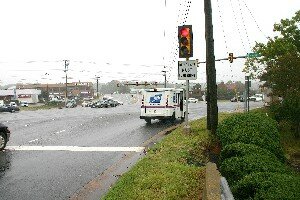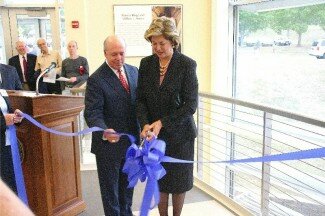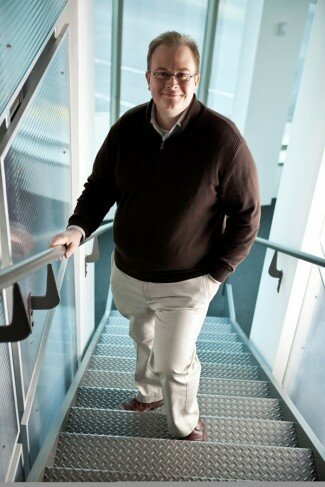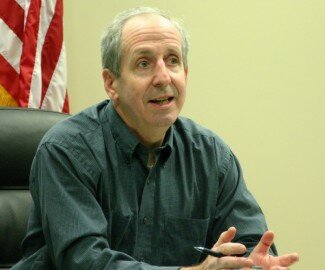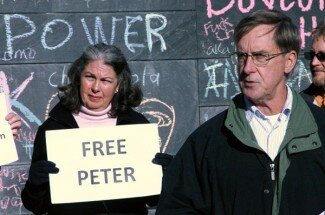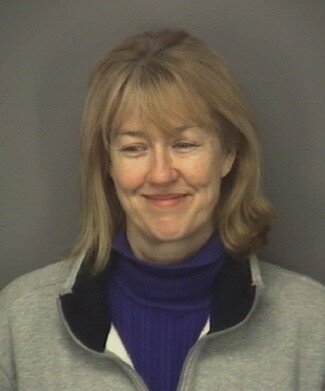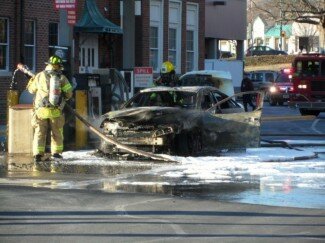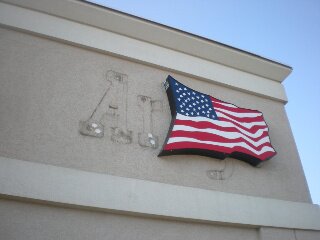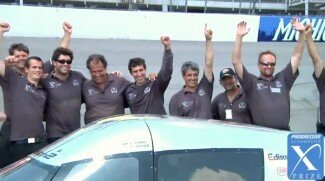 Kuttner (fourth from left) and team designed a car weighing 830 pounds.
YOUTUBE VIDEO
Kuttner (fourth from left) and team designed a car weighing 830 pounds.
YOUTUBE VIDEO
Oliver Kuttner, the Charlottesville real estate developer turned automotive developer, has won the $5 million top prize in the Progressive Automotive X Prize, it was announced Thursday morning, September 16. His Edison2 team’s winning vehicle, a four-seater called the Very Light Car, reportedly gets 102 miles per gallon of fuel and could, Kuttner hopes, reshape the automotive industry.
Kuttner’s quest was the subject of the Hook’s June 17 cover story.
Accolades have begun streaming in. There was a celebratory party hosted by Arianna Huffington, House Speaker Nancy Pelosi spoke at the September 16 victory ceremony held outside the Historical Society of Washington D.C., and Fifth District Congressman Tom Perriello quickly issued a congratulatory statement pointing out that he’s made numerous visits to Kuttner’s Lynchburg laboratory.
Two years ago, Kuttner helped embarrass local water officials— who were busily portraying dredging their main reservoir as impossibly expensive— by offering to dredge for $30 million, a fraction of the quarter-billion one consultant claimed it might cost. “It would be a dream job,” Kuttner said. “I’ll make so much money.”
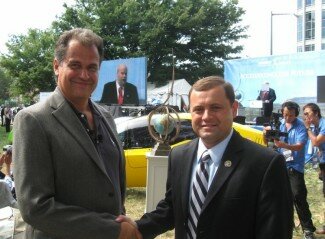 Kuttner gets his flesh pressed by Fifth District Congressman Tom Perriello.
PERRIELLO PHOTO
Kuttner gets his flesh pressed by Fifth District Congressman Tom Perriello.
PERRIELLO PHOTO
His brazen form of entrepreneurship ran him afoul of Charlottesville officials years earlier. He’s the guy who embedded two stone arches salvaged from an old gothic church into the side of the former Woolworth’s building. The City made him remove the arches.
In a 2005 Hook cover story, Kuttner— after sifting through a stack of stop-work orders and other official rebukes— explained that Charlottesville red-tape had pushed him to Lynchburg, where an allegedly more business-friendly environment would smile upon his visions for developing property and, as it turned out, cars.
If officials once fled any association with Kuttner, now they clamor to be associated with the conquering visionary.
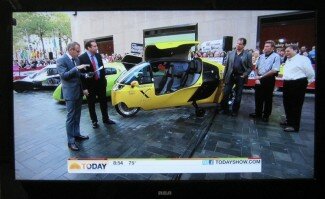 Matt Lauer (left) introduces Kuttner (third from right) to the world on the September 17 Today show.
PHOTO BY HAWES SPENCER
Matt Lauer (left) introduces Kuttner (third from right) to the world on the September 17 Today show.
PHOTO BY HAWES SPENCER
“Every time I visited their lab,” Congressman Perriello says in a statement, “I felt like a witness to history and to a re-imagining of the automobile for a new century. From the scientists to the machinists, they are blazing a path towards the efficient, affordable, American-made technology of tomorrow.”
Meanwhile, U.S. Senator Mark Warner also showed up for the award ceremony and made some gushing statements of his own:
“Edison2’s innovations really represent a home run— not just for Virginia, but for the whole country,” said Senator Warner.
Politicians aren’t the only ones now clamoring for Kuttner. The day after the announcement, he appeared live on the NBC Today show as well as on National Public Radio. But it’s not all champagne and interviews. On Monday, September 20, Kuttner appeared in City Hall, urging City Council to give dredging a try.
“I’ve been thinking about it all weekend,” says Kuttner. “It’s liable to save the citizens over $100 million.”
So how does he deal with his sudden popularity and the fact that he’s been proposing visionary ideas in Charlottesville for several years without much appreciation.
“Some people understand things sooner,” says Kuttner, “and some people understand things later.”
One of the “sooner” folks is Sierra Club Chairman Carl Pope, who posted a video of Kuttner’s X Prize victory speech on his personal blog and called him “2010’s inspiration.”
While Kuttner says Pope’s endorsement has been the “coolest thing” coming out of the X Prize, he’s not slowing down to bask in praise no matter how glowing. By Monday morning, September 20, he was back in the Edison2 workshop in Lynchburg, where the team is now hard at work on a next generation edition of the Very Light Car, this time with an electric engine and assistance from fellow X Prize competitors Li-ion Motors (winner of one of the two-seater X Prize categories) and a firm called TW4XP.
“They have a lot of experience,” says Kuttner.
Also in the cards: raising an additional $3 million to take the company forward. Kuttner declines to reveal the exact amount already invested in Edison2, which he says is now valued at $15 million. But after the next round of fundraising, he says he believes that value will double and continue to rise.
“In a couple of years, this is a couple hundred million-dollar company,” says Kuttner, who is “strongly considering” expanding the company into Campbell County, just outside Lynchburg, or to Michigan.
The economic downturn has been bad for most businesses, but for a start-up car company like Edison2, Kuttner says, there are heretofore unseen opportunities.
“Right now, you can buy machines for $300,000 which, if new, would cost millions and millions of dollars,” he says. “During this crazy time you can do things which you’ll never be able to do again in our lifetime.”
Kuttner’s victory has also spurred environmental groups to action. The L.A. Times reports that in the wake of the X Prize, 19 such groups have joined together to push the government to adopt a 60-mpg standard by 2025. Currently, the 2016 standard is 34.1 mpg.
As for when Very Light Cars might hit the street, Kuttner is cautious about making promises to future buyers and even his own investors.
“We still don’t know our path forward,” he says. But he is certain the car he believes is the best solution for this country’s energy woes won’t hit a dead end.
“We’re not wrong about this,” he says. “We’ve got this tiger by the tail.”
—with additional, on-the-scene reporting by Courteney Stuart
#
–updated 11:19am Friday (60 mpg standard)
—updated 2:35pm Thursday (corrects car weight)
–updated 10:46am Friday (with Today show photo and Mark Warner quote)
–updated 2:12pm, Monday (with a little more about Kuttner’s backstory)
 Nearly 1,000 drivers triggered the red light cameras at 29 and Rio in the first 26 days.
Nearly 1,000 drivers triggered the red light cameras at 29 and Rio in the first 26 days.



 Comments(33)
Comments(33)